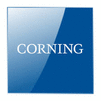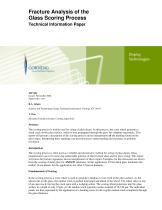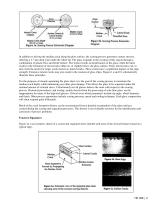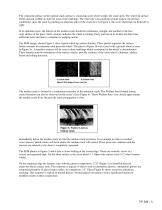
Catalog excerpts

Fracture Analysis of the Glass Scoring Process Technical Information Paper TIP 308 Issued: November 2004 Supercedes: xxxx R.A. Allaire Science and Technology Group, Corning Incorporated, Corning, NY 14831 T. Ono Shizuoka Technical Center, Corning Japan K.K. Abstract The scoring process is widely used for sizing of glass sheets. In this process, the score wheel generates a small crack on the glass surface, which is then propagated through the glass for complete separation., This report will present a description of the scoring process and an interpretation of the marking found on the glass edges. Interpreting these markings can provide process understanding and assistance in problem resolution. Introduction The scoring process is often used as a reliable and inexpensive method for sizing of glass sheets. Glass manufacturers use it for removing undesirable portions of their formed sheet and for glass sizing. This report will focus the fracture signatures and an interpretation of their origins. Examples for this discussion are drawn from the scoring of sheet glass for AMLCD substrates. In this application, 0.7mm thick glass dominates the market. Score wheels for this application, are often 2.5mm in diameter. Fundamentals of Scoring In the scoring process, a score wheel is used to generate a median or vent crack in the glass surface. As the wheel rolls on the glass, the median crack is pushed downward and ahead of the wheel. The wheel rides on top of an open crack, forcing the crack open with a wedging action. The scoring wheel penetrates into the glass surface to a depth of only 2-5pm, yet the median crack typically reaches a depth of 50-120 pm. The individual panels are then separated by the application of a bending stress for driving the median crack completely through the glass thickness. TIP 308 | 1
Open the catalog to page 1
In addition to driving the median crack along the glass surface, the scoring process generates contact stresses, effecting a 3-7 µm deep zone under the wheel tip. The glass responds to the creation of this region through a combination of plastic flow and brittle failure'. The former results in densification of the glass, while the latter results in the formation of microcracks either on, or slightly below, the glass surface. These microcracks can, in turn, form the nuclei for larger cracks known as lateral cracks. These cracks have a significant impact on the edge strength'. Extensive...
Open the catalog to page 2
The contoured surface on the median crack surface is created as score wheel wedges the crack open. The wheel tip surface finish and tool wobble account for most of the markings. The wheel tip’s non-uniform ground surface, the primary contributor, turns the crack by pushing on alternate sides of the crack face. In Figure 2, the score wheel has run from left to right. In an optimum score, the bottom of the median crack should be continuous, straight, and parallel to the face (top) surface of the glass. Such a feature indicates the wheel is running freely and true in its holder and that it has...
Open the catalog to page 3
The scoring process is an integral part of the manufacture of many sheet glass processes. Optimization of the scoring and separation is important to reduce losses from inadequate scoring conditions. Fortunately, a record of the scoring and separation conditions are maintained on the separated glass face. Careful examination and understanding of this record can aid in improving the scoring and separation processes. References: 1. A. Arora, S . Marshall, and B. Lawn, “Indentation DeformationRracture of Normal and Anomalous Glasses”, Journal of Non-Crystalline Solids, vol. 31, p. 415 (1979)....
Open the catalog to page 4
North America and all other Countries Corning Display Technologies MP-HQ-W1 Corning, NY 14831 United States Telephone: +1 607-974-9000 Fax: +1 607-974-7097 Internet: www.corning.com/displaytechnologies Japan Corning Japan K.K. Main Office No. 35 Kowa Building, 1st Floor 1-14-14, Akasaka Minato-Ku, Tokyo 107-0052 Japan Telephone: +81 3-5562-2260 Fax: +81 3-5562-2263 Internet: www.corning.co.jp Nagoya Sales Office Nagoya Bldg., 7 F 4-6-18, Mei-eki, Nakamura-ku Nagoya-shi, Aichi 450-0002 Japan Telephone: +81 52-561-0341 Fax: +81 52-561-0348 China Corning (China) Ltd., Shanghai Representative...
Open the catalog to page 5All CORNING Display Technologies catalogs and technical brochures
-
Gorilla® Glass 5
2 Pages
-
Corning Iris®
2 Pages
-
Aspheres by Corning
2 Pages
-
UltraFlat™
2 Pages
-
Tropel® FlatMaster® MSP
2 Pages
-
Optical Solutions
4 Pages
-
EAGLE XG® Slim
2 Pages
-
Scoring of AMLCD Glass
4 Pages
Archived catalogs
-
Jade® Product Information Sheet
3 Pages
-
Jade® Material Information Sheet
2 Pages

































